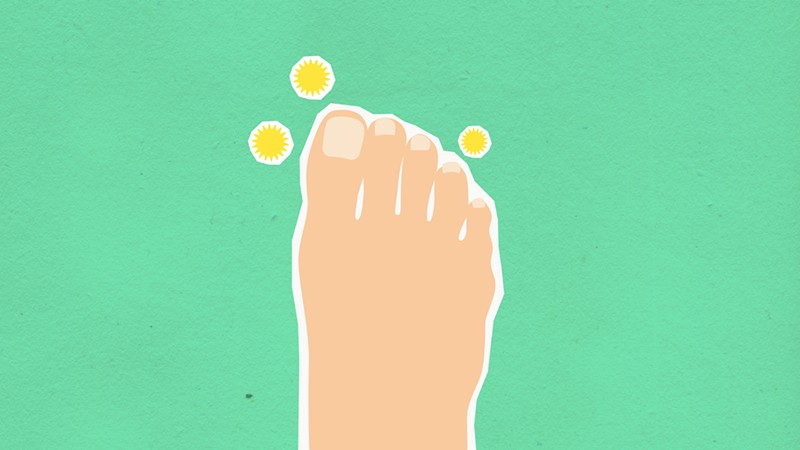
Photo: Pexels, Monstera
Yes, COVID Toe is a thing. Doctors say it's not as serious as COVID-affected hearts or lungs, but it's still not pretty.
As we head into our third pandemic winter, most people are all too familiar with the signs of COVID-19. The disease wears many different faces and can show up as chills, cough, difficulty breathing or other troublesome jumbles of symptoms. But sometimes, this illness can look positively peculiar.
On rare occasions, SARS-CoV-2 rears its head in body parts not typically touched by respiratory viruses. From head to COVID toe, doctors have seen a bevy of bizarre cases. Patchy tongues, puffy digits, hair loss — such issues can be worrisome for patients, says Peter Chin-Hong, an infectious diseases physician at the University of California, San Francisco.
But the outlook doesn’t have to be. That’s because such symptoms can end up going away on their own, says Chin-Hong, who has treated hundreds of people with COVID-19.
No one knows exactly how often COVID tongue, COVID toe, COVID eye or other rare conditions occur — and it’s not always clear that COVID-19 is the actual culprit. Still, the sheer scale of coronavirus infections means that SARS-CoV-2 has had many chances to show its stuff (SN: 9/8/22). The United States is now closing in on 98 million confirmed cases. Such a staggering case count means that “statistically speaking, you’re going to find people with more and more weird things,” Chin-Hong says.
Doctors rely on medical case reports for leads on potential treatments and hints about how long symptoms may last. Even just knowing that someone else has had splotchy mouth sores or tender toes can be helpful, Chin-Hong says. That lets him tell his patients, “You’re not the only one,” he says. “That means a lot to a lot of people.”
Internal medicine doctor Saira Chaughtai published one such study in October in the Journal of Medical Case Reports after one of her primary care patients came in with a symptom Chaughtai had never seen. Ten days after testing positive for COVID-19, the patient’s tongue began to swell, eventually erupting in white-ringed lesions.
Certain spots looked “denuded,” says Chaughtai, of Hackensack Meridian Health in Neptune, N.J. It was as if some of the tongue’s surface bumps had been sandpapered away. The patient wasn’t someone doctors would typically consider vulnerable, either. She was 30 years old, fit and healthy.
“I was like, ‘Oh my god, COVID can do anything,’” Chaughtai remembers thinking.
Oral sores can look different among patients. Chin-Hong has seen people with tongues coated white, as if they’d chewed a mouthful of tortilla chips. For Chaughtai’s patient, COVID tongue felt sensitive and irritated, with flare-ups that burned. Chaughtai wasn’t sure how to treat it.
She searched the scientific literature and prescribed an assortment of mouthwashes, which helped. But six months in, the patient’s tongue hadn’t fully healed. So Chaughtai got creative. She teamed up with a sports medicine doctor, who beamed low-level laser light at the patient’s tongue. He had previously used this photobiomodulation therapy to treat muscle injuries.
Laser light therapy makes blood vessels dilate, enhancing blood flow to treated areas, which could promote healing, Chaughtai says. It seemed to work for her patient. The tongue lesions began to heal and flare-ups subsided. The woman still occasionally feels some tongue sensitivity when stressed, but never as bad as her initial outbreak.
The effects of COVID toe
About 1,300 kilometers west, a podiatrist in Crown Point, Ind., also dilated a patient’s blood vessels to treat a curious coronavirus condition: COVID toe. After infection with SARS-CoV-2, patients’ fingers and toes can plump up, sometimes painfully, and turn pink or reddish purple.“We were seeing cases of these lesions that look like chilblains, which is something you get when you’re exposed to cold weather,” says Michael Nirenberg of Friendly Foot Care. But his patients hadn’t been in the cold — they’d been exposed to the coronavirus.
Nirenberg has seen as many as 40 people with the symptom, which he’s found tends to clear up in a month or two. But one of his patients, a 59-year-old man, just couldn’t kick COVID toe. It ultimately lingered for nearly 670 days — the longest documented case Nirenberg has seen. “The term we used was long COVID toe,” he says. Nirenberg and colleagues reported the case this spring in the Journal of Cutaneous Pathology.
Nirenberg prescribed daily application of a nitroglycerin ointment to boost blood flow to the toes. That may have helped, Nirenberg says, “but I don’t know if time also did the trick.” After 22 months, the condition may have finally resolved on its own.
The number of COVID toes Nirenberg encounters these days has gone down, but he’s still seeing people come in with the condition. And though Chaughtai has not treated another case of COVID tongue, a man recently e-mailed her saying that he had suffered from a similar affliction for two years.
UCSF’s Chin-Hong says he thinks it’s important for people to know that COVID-19 can cause such a variety of symptoms (SN: 11/11/22). “We can’t really predict who’s going to get what,” he says. But in his experience, strange symptoms have tended to crop up more often in people who haven’t been vaccinated.
Such symptoms may not be as serious as COVID-affected hearts or lungs, but they can certainly look scary, Chin-Hong says. “If this is a reason why some people might get vaccinated,” he says, “I think that would be great.”
This story was originally published by Science News, a nonprofit independent news organization.
Coming soon: CityBeat Daily newsletter. We’ll send you a handful of interesting Cincinnati stories every morning. Subscribe now to not miss a thing.
Follow us: Google News | NewsBreak | Reddit | Instagram | Facebook | Twitter





